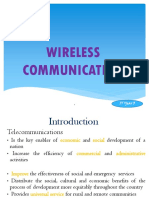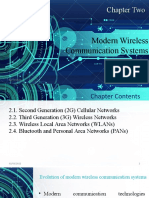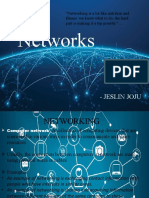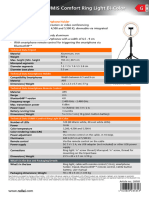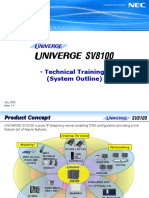2.
4 Mobile Communication
Mobile Communication refers to the technology and infrastructure that enable wireless communication
between mobile devices and other systems. It involves the transmission of voice, data, and multimedia
over wireless networks. Here is an overview of its key components, types, and features:
Bluetooth is a wireless communication technology that allows devices to exchange data over short
distances using radio waves. It is widely used for connecting devices like smartphones, headphones,
laptops, and other peripherals without the need for cables. The International Enterprise for
Electronics Engineering (IEEE) 802.15.1 committee is responsible for Bluetooth standards
Key Features of Bluetooth
1. Short-Range Communication:
o Operates typically within 10 meters (33 feet) for standard devices, though some advanced versions
can go up to 100 meters.
2. Low Power Consumption:
o Designed to use minimal power, making it suitable for portable and battery-operated devices.
3. Global Compatibility:
o Operates in the unlicensed ISM band (2.4 GHz), making it usable worldwide.
4. Secure Connection:
o Incorporates encryption and authentication mechanisms for secure data transfer.
5. Versatility:
o Supports multiple use cases such as audio streaming, file transfer, and device control.
Versions of Bluetooth
1. Bluetooth 1.0 & 1.1: Initial versions, limited speed and reliability.
2. Bluetooth 2.0 + EDR: Enhanced Data Rate (EDR) introduced for faster transfer speeds.
3. Bluetooth 3.0 + HS: High-Speed (HS) feature for faster data transfer using Wi-Fi support.
4. Bluetooth 4.0: Introduced Bluetooth Low Energy (BLE) for IoT applications.
5. Bluetooth 5.0 and Beyond: Improved range, speed, and broadcasting capabilities; optimized for
smart devices and IoT.
Applications of Bluetooth
1. Audio Devices: Wireless headphones, speakers, and hearing aids.
2. File Sharing: Transfer of photos, documents, and other files between devices.
3. IoT Devices: Smart home appliances and wearable tech.
� 4. Health Monitoring: Fitness trackers, heart rate monitors, and medical devices.
5. Gaming and Controllers: Wireless game controllers and VR accessories.
Advantages of Bluetooth
1. Wireless Convenience: Eliminates the need for cables.
2. Energy Efficiency: Ideal for devices that rely on battery power.
3. Affordable and Widely Supported: Built into most modern devices at no additional cost.
Limitations of Bluetooth
1. Limited Range: Effective over short distances only.
2. Interference: Susceptible to interference from other wireless devices operating in the same
frequency band.
3. Data Transfer Speed: Slower compared to Wi-Fi and other technologies for large file transfers.
Wireless Local Area Network (WLAN)
A Wireless Local Area Network (WLAN) is a type of local area network (LAN) that uses wireless
communication technology to connect devices within a limited geographical area, such as a home,
office, or campus. WLAN eliminates the need for physical cables, providing greater flexibility and
convenience.
Components of WLAN
1. Access Point (AP): Acts as the central hub, enabling wireless devices to connect to the network.
2. Wireless Devices: Laptops, smartphones, printers, IoT devices, and other Wi-Fi-enabled gadgets.
3. Network Interface Card (NIC): Hardware in devices that allows them to connect to a WLAN.
4. Router: Manages traffic between the WLAN and external networks like the internet.
2.5 Cellular Networks
A cellular network is a type of wireless communication system that divides a geographic area into
smaller regions called cells. Each cell is served by a base station to enable seamless communication
across the network. This system forms the backbone of mobile communication and allows for efficient
use of the radio spectrum.
Key Concepts of Cellular Networks
1. Cells and Base Stations:
o The land area covered by the network is divided into cells, with each cell having its own base station
(BS) or transceiver.
�o Base stations are fixed-location devices powered by solar energy or AC electricity. They transmit and
receive signals to and from mobile devices in their coverage area.
2. Mobile Switching Center (MSC):
o A Mobile Switching Center is a centralized system that connects calls between base stations and the
wider telephone or internet network.
o The MSC handles:
Call coordination between base stations.
Recording call data for billing purposes.
Connecting to other networks, such as the Public Switched Telephone Network (PSTN).
Generation of Cellular System
The cellular communication networks are known by their numeric generation such as 1G, 2G, 3G and
4G designations. We are currently in the fourth generation with 5G emerging.
Types of cellular system
1. First Generation (1G):
o Analog voice communication with basic functionality.
o Limited capacity and poor security.
2. Second Generation (2G):
o Digital voice communication and SMS (Short Messaging Service).
o Technologies: GSM, CDMA.
3. Third Generation (3G):
o Introduced mobile data, allowing internet access.
o Faster speeds for multimedia and email.
4. Fourth Generation (4G):
o High-speed internet and better voice quality with VoLTE (Voice over Long-Term Evolution).
o Supports video calling, HD streaming, and gaming.
5. Fifth Generation (5G):
o Ultra-fast data speeds, low latency, and massive device connectivity.
o Enables advanced applications like IoT, autonomous vehicles, and smart cities.
2.6 Satellite Networks
� A satellite network is a communication system that uses satellites to relay signals between different
locations on Earth.
Satellites act as nodes in the network, facilitating long-distance communication without requiring
direct physical connections like cables.
Key Components of Satellite Systems
1. Earth Stations:
o Ground-based facilities with antennas that send and receive signals to and from satellites.
2. Uplink:
o The transmission of signals from an earth station to a satellite.
3. Downlink:
o The transmission of signals from a satellite to an earth station.
4. Transponder:
o A component on the satellite that receives uplink signals, amplifies them, and retransmits them on a
downlink frequency.
Satellite Orbits
An orbit is the specific path a satellite follows around the Earth. Orbits can vary based on their altitude
and orientation:
1. Equatorial Orbit:
o Aligns with the Earth's equator.
2. Inclined Orbit:
o Tilted relative to the Earth's equator.
3. Polar Orbit:
o Passes over the Earth’s poles, covering the entire surface over time.
Categories of Satellites by Orbit
Satellites are classified based on the altitude of their orbits:
1. Geostationary Earth Orbit (GEO):
o Altitude: 35,786 km above the equator.
o Characteristics:
Appears stationary relative to a point on Earth.
Ideal for television broadcasting, weather monitoring, and communication.
�o Advantage: Constant coverage of a specific area.
o Limitation: High latency due to the distance from Earth.
2. Medium-Earth Orbit (MEO):
o Altitude: 5,000 to 15,000 km.
o Characteristics:
Typically used for navigation systems like GPS.
Provides moderate latency and coverage.
3. Low-Earth Orbit (LEO):
o Altitude: Below 2,000 km.
o Characteristics:
Used for data communication (e.g., Starlink, OneWeb).
Provides low latency and higher signal strength.
o Advantage: Faster data transmission due to proximity to Earth.
o Limitation: Requires a constellation of satellites for continuous coverage.
Applications of Satellite Networks
Global Communication: Enables internet, telephony, and television broadcasting.
Navigation: Used in GPS and other global positioning systems.
Remote Sensing: Provides data for weather forecasting, environmental monitoring, and disaster
management.
Military and Defense: Facilitates secure communication and surveillance.
Satellite networks play a critical role in bridging communication gaps in remote or inaccessible areas
and supporting global connectivity.



















